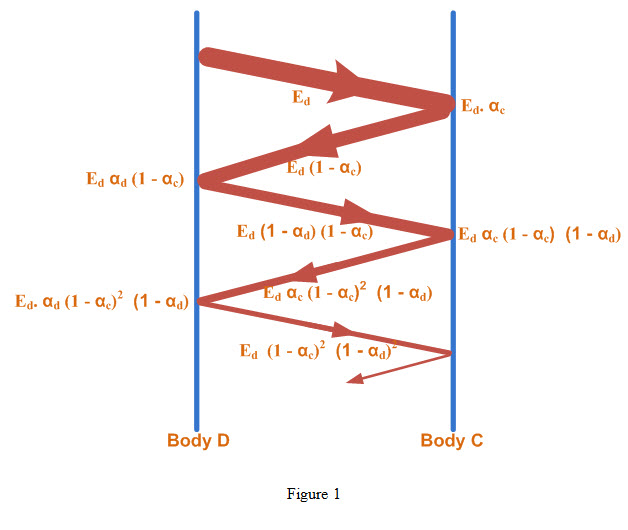Site pages
Current course
Participants
General
Module 1. Basic Concepts, Conductive Heat Transfer...
Module 2. Convection
Module 3. Radiation
Module 4. Heat Exchangers
Module 5. Mass Transfer
Lesson-23 Radiation between two infinite parallel plates and proof of Kirchhoff’s law of Radiation, Radiation Shield
Radiation between two infinite parallel plates and proof of Kirchhoff’s law of Radiation:
At a given temperature, the total emissive power of a any body is equal to its absorptivity multiplied by total emissive power of a perfect black body at that temperature.
Therefore E = αEb
But the ratio of total emissive power of any body to the total emissive power of a black body at the same temperature is called the emissivity of the body and is numerically equal to absorptivity.

Consider two bodies C and D whose absorptivity are αc and αd as shown in Figure 1.

Considering the energy emitted by the body D.
(1) D emits the energy = Ed (1)
(2) C absorbs energy = Ed. αc (2)
and reflects energy=Ed (1 - αc) (3)
(3) D absorbs energy = Ed αd (1 - αc) (4)
and reflects energy = Ed (1 - αd) (1 - αc) (5)
(4) C absorbs energy = Ed αc (1 - αc) (1 - αd) (6)
and reflects energy = Ed (1 - αc)2 (1 - αd) (7)
(5) D absorbs energy = Ed. αd (1 - αc)2 (1 - αd) (8)
and reflects energy = Ed (1 - αc)2 (1 - αd)2 (9)
and so on upto times.
Considering the energy emitted by the body C.
(1) C emits the energy = Ec (10)
(2) D absorbs energy = Ec. αd (11)
and reflects energy=Ec (1 – αd) (12)
(3) C absorbs energy = Ec αc (1 – αd) (13)
and reflects energy = Ec (1 – αc) (1 – αd) (14)
(4) D absorbs energy = Ec αd (1 – αd) (1 – αc) (15)
and reflects energy = Ec (1 – αd)2 (1 – αc) (16)
(5) C absorbs energy = Ec. αc (1 – αd)2 (1 – αc) (17)
and reflects energy = Ec (1 – αd)2 (1 – αc)2 (18)
and so on upto infinite number of times.
Considering equations (1), (4), (8), (11), (I5), net energy lost by the body D
= Energy emittedby it – energy absorbedby it
q(dc) =Ed – [Ed αd (1 - αc) + Ed. αd (1 - αc)2 (1 - αd) + ….] – [Ec. αd + Ec αd (1 – αd) (1 – αc) +….]
Assuming (1 - αc) (1 – αd) = K
q(dc) = Ed – Ed αd (1 - αc) [1 + K + K2 + …...] – Ec. αd [1 + K + K2 + ….]
But 1 + K + K2 + …... = (1 –K)-1
q(dc) = Ed – (1 –K)-1 [Ed αd (1 - αc) + Ec. αd ]

i) If originally both bodies are at same temperature
Then q(dc) = 0 from equation (18A)
Ed ac = Ec ad
Assuming C as black body

Subscription ‘b’ represents black body.
However, Ed / Eb is the emissivity of body ‘D’ according to definition of emissivity.
εd = αc This is the statement of Kirchoff’s law and hence it is proved.
ii) If both the bodies are at different temperatures
Using equation (19)

According to Stefan-Boltzman Law
Ed = εd σb T14
Ec = εc σb T24
Substituting these values in equation (19), we get

Radiation Shields
Generally, the shields are used for reducing the heat radiation from one plane to another plane. If the shield 3 is placed in between the two planes as shown in Figure 2 and considering they are at temperatures T1, T2 and T3.

Assuming there is no temperature drop in the shield and considering the system is in steady state condition, we can write down the heat flow equation as


It means that with the addition of radiation shield, heat transfer rate is reduced to half of that of without the presence of radiation shield between two parallel bodies exchanging heat with each other by radiation. If ‘n’shields are present between the two radiating bodies, then the heat transfer will be expressed as
